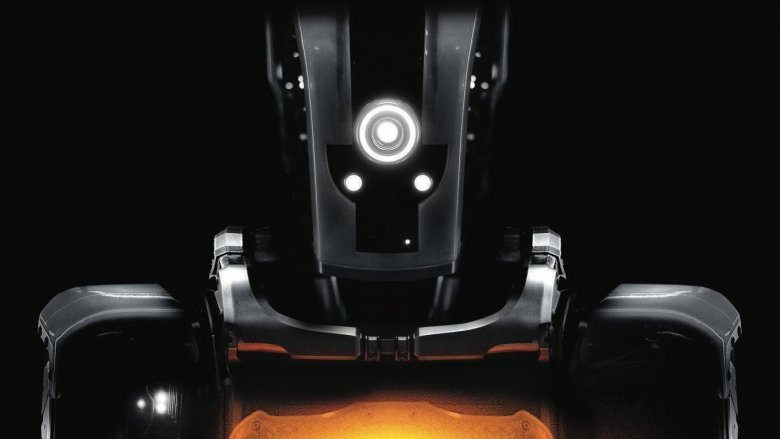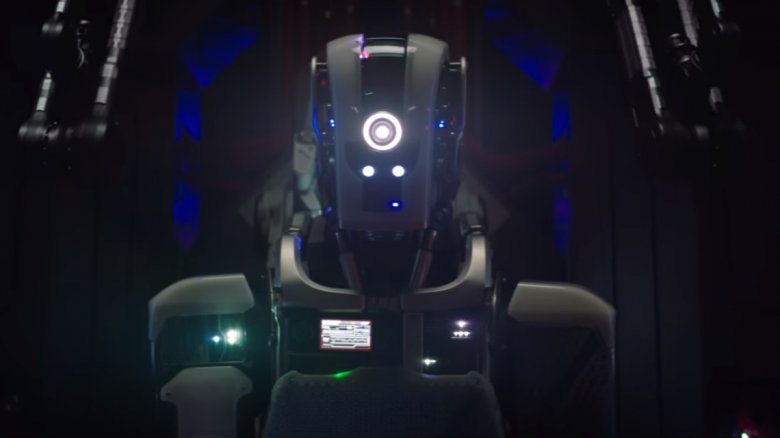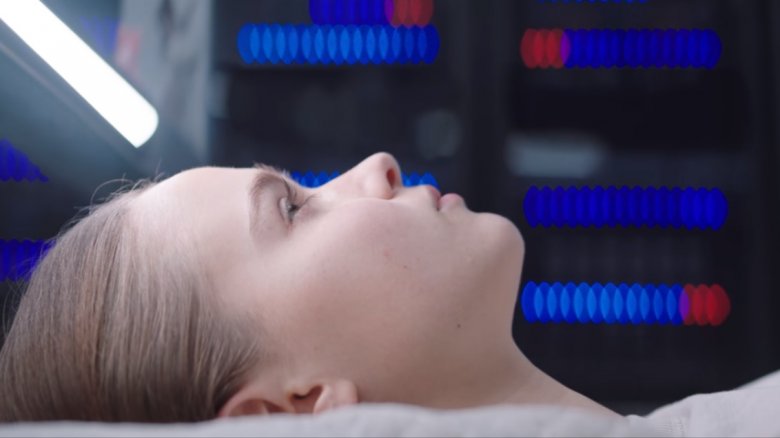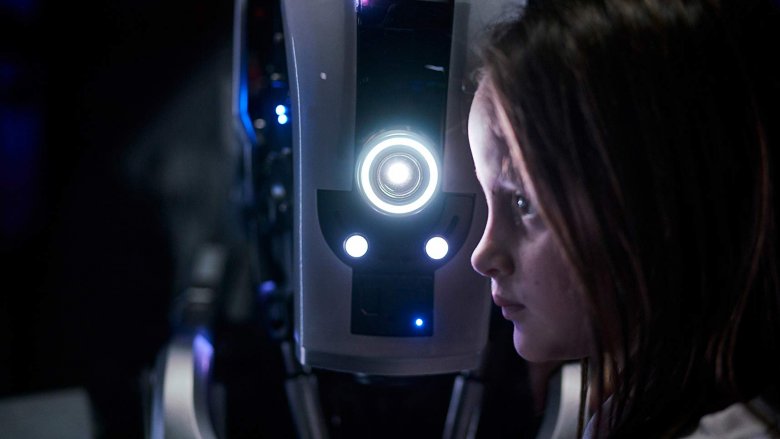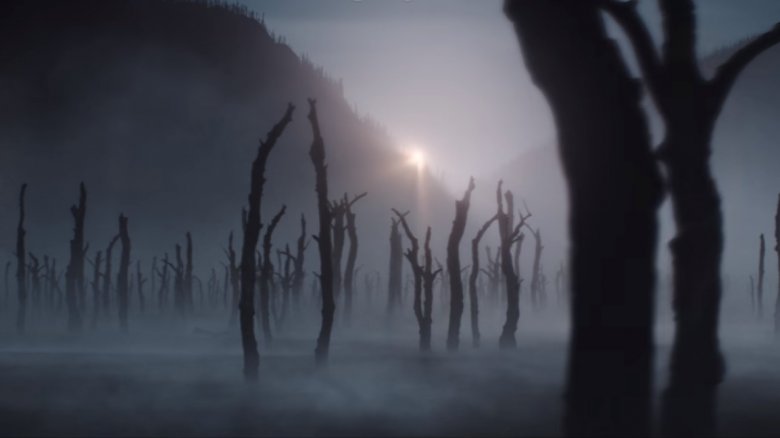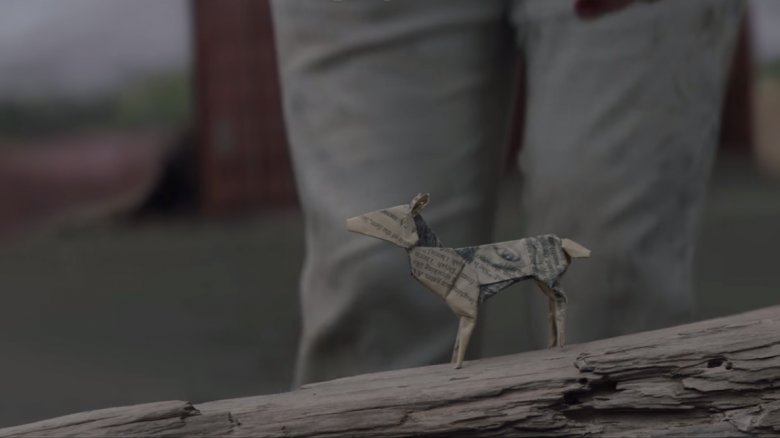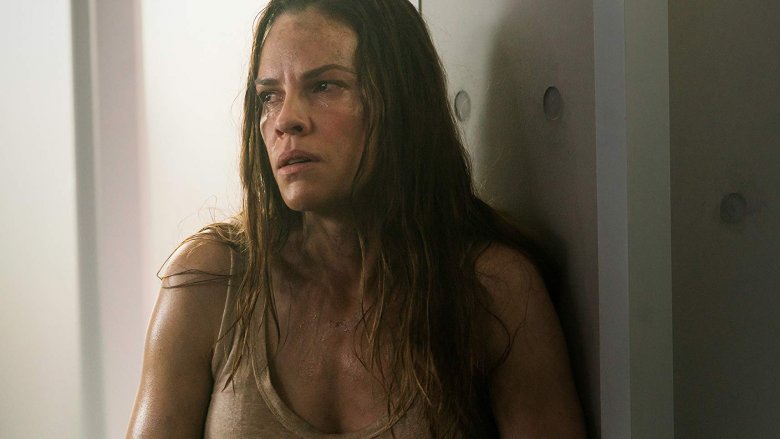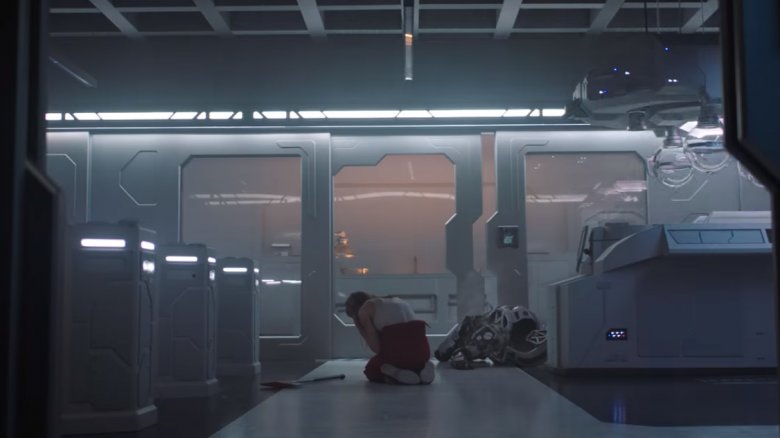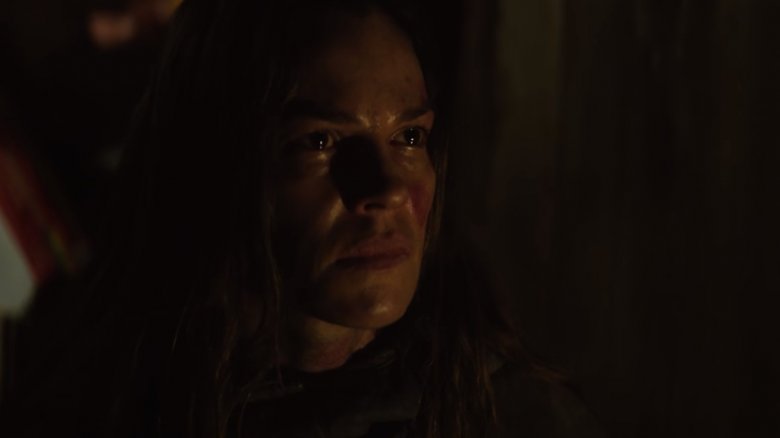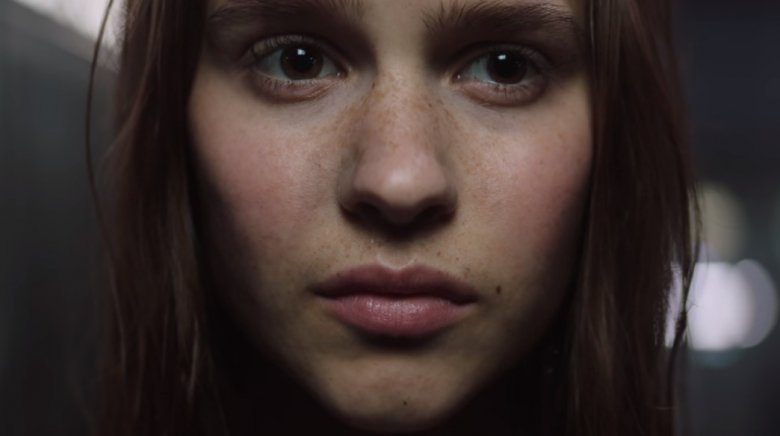The Ending Of I Am Mother Explained
Moms can be tough — but the apocalypse can be tougher. Netflix's new sci-fi movie I Am Mother, the first feature from Australian director Grant Sputore, is a stripped-down story about trust, faith, and an intimidating WETA-designed robot with a sweetheart's voice and, just maybe, the parental instincts of your average Terminator.
Following a limited cast that includes Clara Rugaard, Hillary Swank, and the voice of Rose Byrne (recording her lines over an ace physical performance by actor, stuntman, and SFX designer Luke Hawker), I Am Mother is a story of shifting allegiances and slow reveals, layering on the twists at an even clip until it's hard to know what to believe anymore.
What's the true nature of this frightening future world? What drove a seemingly benevolent robot to raise a human child as her own, and what was the meaning of where it all led? If you were too stunned by the spectacle to catch every detail of the movie's denouement, it's hard to blame you. Let's examine the finer details of the bittersweet ending of I Am Mother.
Future shock
The movie begins in what is described as a Repopulation Facility, one day after an extinction event of unknown nature. Text over the opening shots explains that the facility is stocked with 63,000 human embryos; save for the audience's observing eye, there are no humans inside.
In a largely wordless opening sequence, the robotic Mother comes to life, seemingly ready to begin the hard task of repopulating the world. It's an interesting scene to go back to once you've seen the movie, and you realize that this robot and the extinction event have a whole lot in common with each other. She's not a failsafe in the case of extinction — she's the cause of it, and Mother is but one of her many faces.
Mother doesn't come to life out of some automated altruism. She's a madwoman of a machine — Skynet meets the Matrix meets a metal Mommie Dearest, executing a single-minded plan to remake the human race to suit her own needs and twisted logic.
All of this is on display at the start of the movie; you're just not inclined to notice at first. Rose Byrne has a very soothing voice, and caring for a baby with not just nutrition and shelter, but bedside stories and time for play makes the robot seem implicitly compassionate. But these are merely superficial things that keep you trusting Mother long after you should have become suspicious of her, much like our protagonist, the unnamed Daughter character.
Missing time
The next time stamp we see in the movie marks 13,867 days since the extinction event. You may not have noticed it at first, but right away, there's something wrong here. 13,867 divided by 365 would make for almost 38 years, and Daughter at this time is clearly only half that age. This hasn't been a straight line from day one; something has happened that we haven't seen. (As Amy Nicholson's review of the film for Variety puts it, "math whizzes may catch [this] early tip-off.")
What happened in those missing years before our protagonist was born? The answer, we learn, is tragic.
When we're introduced to Daughter, she is nearing the end of her studies with Mother, preparing for an ambiguous exam, steeped at least partially in questions of human ethics. Passing the exam appears vitally important, but why? If Mother and Daughter are the only sentient beings alive, then who are these exam results supposed to impress?
The answer is: only Mother. By the end of the movie, the implication is clear: there were children before Daughter, and they did not measure up. The Daughter we meet is only the latest attempt at raising a woman who passes Mother's muster.
We can divine from Mother's actions, from getting better at telling jokes to trying out new cake recipes, that this machine learns from her mistakes, and adapts her behaviors in pursuit of better results. Will this exam end differently? For Daughter's sake, it'd better.
Lies my teacher told me
The first big wrench in the plot is the arrival of an injured woman at the facility, after Daughter has been led to believe that no other humans except her still exist. This occurs after Daughter has already begun to question Mother thanks to the presence of a mouse in the facility — and you know you're starved for company when a mouse in the house excites you.
By the time the woman arrives, desperate and bleeding from a gunshot wound, tiny pinpricks have been poked in Daughter's understanding of the world — holes that the woman's presence, and the questions she raises, will tear wide open.
For the first time ever, Daughter's allegiances are tested. Who should she trust? The woman says robots like Mother are killers who destroyed the world, but after examining the woman's bullet wound, Mother claims the woman was shot by another human's weapon — not a so-called Dozer like herself.
When Daughter interrogates the woman, she's implored to seek out answers for herself, comparing the bullet inside the woman with one she shot at Mother. When Daughter does so, she learns the woman is telling the truth.
Digging deeper, she uses Mother's "fingerprint" to comb through other archives, discovering that Mother has also kept the existence of a previous daughter from her — one she killed and incinerated, just like the mouse, after failing her exam. It's one heck of a reality check. Daughter's allegiances shift dramatically, and things can never be the same.
Reality bites
Daughter only hesitates in leaving with the woman because of her still-gestating brother, but circumstances force the two to leave in a hurry, before the baby is born. For this and other reasons, Daughter's salvation soon goes south.
Daughter's departure is partially motivated by a promise of other humans still alive, taking refuge in far-off mines. The only proof of their existence is drawings the woman has made of them in a copy of Edgar Rice Burroughs' The Gods of Mars — compelling evidence, but hardly conclusive.
In joining the woman, Daughter essentially trades Mother in for another maternal figure — one whom she quickly begins rebelling against when she realizes her story doesn't add up. Instead of fleeing to the mines, they journey to a beach full of washed-up shipping containers, one of which the woman has been using as a home. There are no others — she is alone.
The woman reveals that she fled the mines years ago, with conditions being so dire that she feels certain everyone she knew there is now dead. From her drawings, it's clear she yearns for companionship. To regain it, she's selfishly stretched the truth, offering Daughter false hope in exchange for her fleeting trust.
It backfires, with Daughter realizing that she had kind of a good thing going on back at Mother's house. Now now she's hanging out in a shipping container with a violent, duplicitous weirdo. This kind of thing can happen when you run away from home.
Turning the page
With the woman having betrayed Daughter's trust, she retreats outside of the shipping container, studying a page of the woman's hand-drawn portraits. Before long, the woman's dog — only the second animal Daughter has ever seen in the flesh — approaches to say hey, as dogs do, seeming to have little awareness of the apocalyptic conditions all around him. They share a moment, and Daughter comes to a decision.
When she departs to return to Mother, Daughter leaves behind the page, folded up as a piece of origami in the shape of a dog for the woman to find. The origami piece is similar to the same designs Daughter has been seen making throughout the movie since early childhood, entertaining herself as best she can in a world without PlayStation. Though the folded-up portrait is now mostly unrecognizable, a single watchful eye is emphasized.
To the viewer, the origami is a clear reference to a moment in the non-theatrical editions of sci-fi classic Blade Runner, when the protagonist Deckard is left a paper unicorn by a man who may have ties to his past. In that story, it's a roundabout way of indicating that Deckard may be just as much of a robot as the Replicants he's hunting — even if he doesn't know it. But what does the dog origami signify to the woman in this story?
These are no pets. But without them...
It all goes back to one of the first exchanges between Daughter and the woman, when the woman is healing up in the facility. Sneering at perceived condescension on Daughter's part, the woman asks if she only regards her as something trivial to take care of — "a little pet friend," as she puts it.
Dogs are, of course, domesticated animals, who can be trained to behave as their owners expect them to. As the woman comes to find out by the movie's end, she's not so independent as she first appears. Matter of fact, she's not even close to being outside of Mother's control. As we learn at the end of her story, she's been kept alive and taken care of quite deliberately by Mother's machinations, all to play a role in her master plan for humanity's future. She's not a survivor of her own accord — as the origami seems to symbolize, she's merely a pet after all.
But the woman's not just a pet, not really. She's a vital part of Mother's carefully designed ecosystem. When Daughter is watching a nature documentary earlier in the movie, a telling line of voiceover can be heard in reference to some wild animals, maybe long extinct. It's a short line, but in retrospect, it's clearly a reference to the woman: "Part wolf, part dog, these are no pets. But without them, the Eskimos would not manage..."
Homecoming
When Daughter returns to the facility, granted easy access by the army of robots outside, Mother finally shows who she really is. She tries to bring Daughter into her trust by telling her that, thanks to her guidance, she's not like other humans. She's meant for better things, and has been provided better resources, more chances, than the people who once lived outside. (It's a regular Aunt Becky situation.)
Daughter is unmoved, taking custody of her brother and spitting venom at Mother for killing the children who didn't measure up. Suddenly, we're in Terminator meets Aliens, with Daughter sprinting for her life while protecting a defenseless child from an unstoppable enemy. This attempt at escape quickly becomes untenable with the revelation that Mother is not just one robot, but all robots — a unified single consciousness, practically unkillable, an army unto herself. (And you thought your mom was tough.)
Daughter abandons the fighting approach and instead begs for a chance to prove herself as an independent caretaker of her brother, pleading for trust. After all, she's earned it, right? She's passed her exam, right? The appeal works, and Mother acquiesces, stopping the invasion of the station from the other Dozers outside, and letting Daughter fatally shoot her right in her heart — or CPU. Daughter has earned her independence. The facility is hers.
Controlled opposition
Back at the beach, the woman, alone again, doodles a picture of Daughter on another book page in silent contemplation. Because her operational security is apparently kind of trash, she only just now finds a sort of blinking red tracking device that Mother has previously been seen building and slipping into her bag. Upon discovering the device, she is promptly approached and cornered by yet another body of Mother.
As it turns out, it's the woman's turn to get a knowledge bomb dropped on her head, with Mother revealing that she's much more responsible for the woman's years of survival than the movie has yet let on.
It is chillingly implied that she is not just a useful Idiot for Mother's machinations, but a creation of Mother herself, lab-grown and micromanaged just as much as Daughter has been. Perhaps she was among the first people Mother raised from the embryo stores, 38 years ago, before she was found and raised as an apparent orphaned child by a kindly couple of extinction event survivors.
It seems that her arrival to the facility didn't interrupt Daughter's exam, but was actually a key part of it, with Mother having been pulling the levers this whole time from behind the curtain like a regular Wizard of Oz. She played her role to perfection — and now that Daughter has passed her exam, her continuing existence is unnecessary. She dies offscreen by Mother's hand, her role in the plan concluded.
I'm the mother now
I Am Mother ends with Daughter back where she started, but with her situation completely changed. She's learned the truth about Mother, to a certain extent, and knows she cannot trust her. But she's also now experienced and been lied to by the outside world as well. As Blink-182 once put it, "I guess this is growing up."
Though her journey outside the facility with the woman was short, it was immensely consequential. Now she is, Daughter feels, a wiser person who's learned to trust herself — not the outside world, nor the robot who raised her. She'll pass this wisdom on to her brother, a helpless child whom she is now determined to raise. It's a development that re-contextualizes the story you've been watching, right down to its very title. She's the mother now.
Make no mistake, though — this is far from an empowering ending, however much it may feel like one to Daughter herself. In killing and replacing Mother, she is only fulfilling Mother's master plan of creating a newer, better version of the human race. She feels independent, but she's not. This was all a part of Mother's plan.
As the movie comes to a close, Daughter regards the thousands of remaining embryos in the facility, preparing for the daunting task ahead. Mother as she knows her is gone, but her plan lives on. No matter what Daughter does next, she will always be her Mother's child.
